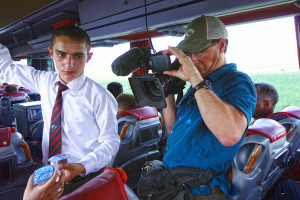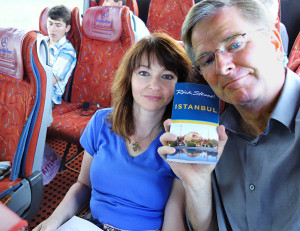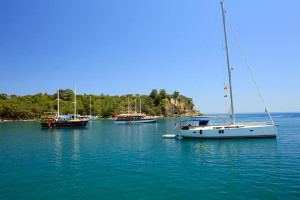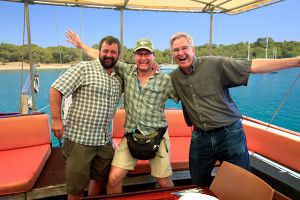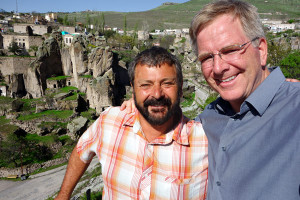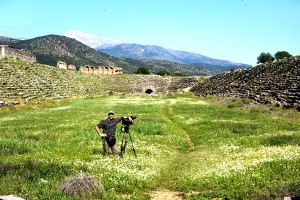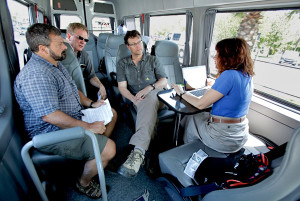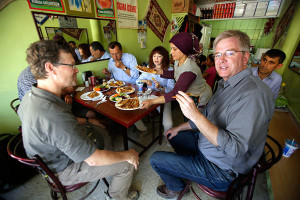I try to show the more mundane realities of travel along with all the glorious sights in my shows. For instance, when exploring Turkey, the bus system is excellent: I wouldn’t drive or take the train. The best approach for travelers is to take cheap flights for long hops and intercity buses for shorter trips. Another fun dimension of traveling here is taking a little cruise along the Turkish Riviera.
Ballooning over Cappadocia
I’ve never been big on ballooning. It’s expensive, you need to get up really early, and I’m a little bit afraid of the whole thing. Ballooning is popular in France’s Loire Valley and in Egypt’s Luxor on the Nile, but it’s even more popular in Cappadocia in central Turkey. I ballooned for my first time here a year or so ago as I was scouting for our TV shoot. The experience was so majestic, I knew I’d be back with the crew.
Ballooning has had a tough 2013. First there was the tragedy in Luxor, Egypt, in February killing 19, and then on May 20 a balloon right here in Cappadocia collided into another one — killing two tourists. But hundreds go up every day throughout the season — as they have now for several decades. It’s a calculated risk people have to decide for themselves. Floating silently over the pinnacles of Cappadocia is truly a travel experience of a lifetime, and I wanted to share it on TV.
What’s your take on ballooning in your travels? Where is it best? Do you feel it’s safe?


Turkey Shoot — Producing Two New Programs in Anatolia
I have long found Turkey one of the most exciting destinations in (and around) Europe. We have two shows on central and western Turkey that date back to the turn of the century, and it’s time to update things.
Everyone talks about “tough economic times” these days. It’s human nature and it’ll be that way for the rest of our days. It seems no one is ever rich enough. But, as a traveler, I try to stay apart from all that moping. Turkey is far poorer than the USA but, for the average person and compared to any time in history, Turkey is booming. I am very happy for the country — even though that means a little of the romantic shabbiness I find so attractive is a thing of the past. Our old TV shows focused on that shabbiness. It’s my nature as a travel writer to look for the rustic, old-fashioned, odd bits that fall through the cracks. I am doing my best to be more honest about Turkish society on this shoot. It is a success story, and we’ll show it that way as we dedicate 12 days to making two new shows.
Our first program starts in the cruise port of Kusadasi, ventures inland to the great ancient sights of Ephesus and Aphrodisias, then travels to the religious and conservative city of Konya (home of the dervishes), and finishes with a little cruise from the Mediterranean resort of Antalya. The second episode focuses on Cappadocia and the modern capital of Ankara. This happens to be exactly what we cover (along with Istanbul) in our popular Turkey in 13 Days tour.
Konya: Where Monks Whirl
The tenor of towns in Turkey changes depending upon how religious and conservative they are. Among western-oriented, secular, cosmopolitan Turks, Konya is not a favorite place. More women wear scarves here, and it’s filled with pilgrims who come to visit the tomb of Sufi mystic Rumi (better known to Turks as Mevlana, meaning “master” in Persian). While I probably wouldn’t like to live here, as a traveler I really like Konya.



Istanbul’s Grand Bazaar Hums Along
I enjoyed updating our Istanbul guidebook’s Grand Bazaar chapter. While the main streets of the vast market are jam-packed with cruise groups and other tourists, explore into the back lanes and you find yourself far from the tourist scene. I was able to peek into amazing and surprising worlds. At this shop I was impressed by complexity of making a simple gilded ribbon for fancy local clothing. In Istanbul, when you stumble into something interesting, it generally comes with a warm welcome and the offer of a cup of tea.
If you can’t see the video below, watch it on YouTube.
